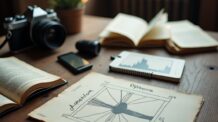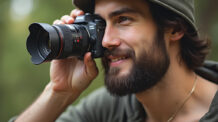Starting out in photography can be exciting — but also a bit overwhelming. There’s a sea of gear on the market, from high-end equipment to budget-friendly tools. The truth is, you don’t need every gadget to take great photos. What matters most is having the right essentials to help you learn, grow, and enjoy the process.
In this article, we’ll go over the must-have photography gear for beginners, focusing on affordability, functionality, and real value for your journey.
1. A Beginner-Friendly Camera
You can’t be a photographer without a camera — but that doesn’t mean you need the most expensive one.
What to look for:
- Interchangeable lenses (DSLR or mirrorless) for flexibility
- Manual mode options for learning exposure
- Built-in screen with live view
- Lightweight design if you plan to travel or shoot on the go
Great beginner models:
- Canon EOS R100 (mirrorless)
- Nikon D3500 (DSLR)
- Sony ZV-E10 (mirrorless)
- Fujifilm X-T30 II (mirrorless)
💡 Tip: Even a used or refurbished model can be a smart start.
2. A Versatile Lens
Your lens plays a big role in the final look of your photos. Most cameras come with a basic kit lens (usually 18-55mm), which is great for learning.
Recommended beginner lenses:
- 50mm f/1.8 “Nifty Fifty” – affordable and great for portraits
- 35mm f/1.8 – versatile for street, travel, and lifestyle shots
- Kit zoom (18–55mm or 16–50mm) – general use and landscapes
Wide apertures like f/1.8 or f/2.8 help in low light and create beautiful background blur (bokeh).
3. A Sturdy Tripod
Tripods are essential for sharp long exposures, night photography, landscapes, and even self-portraits. It also teaches you to slow down and compose carefully.
What to consider:
- Lightweight (carbon fiber or aluminum)
- Adjustable height and head movement
- Sturdy enough to hold your camera safely
Bonus: Use a tripod + self-timer for family or solo photography.
4. A Camera Bag
Protecting your gear is a priority, especially if you shoot outdoors or on the move. A good camera bag organizes your gear, protects it from bumps and weather, and keeps everything accessible.
Features to look for:
- Padded compartments
- Water resistance
- Space for camera, lenses, batteries, and SD cards
- Comfortable straps
You don’t need a huge backpack — a compact shoulder or sling bag works perfectly for most beginners.
5. Extra Memory Cards
Running out of storage mid-shoot is frustrating. Always have a few extra SD cards in your bag.
Tips:
- Use Class 10 or UHS-I cards for fast writing speeds
- Stick with 32GB or 64GB to avoid massive files on one card
- Format cards regularly to maintain performance
🔒 Always back up your photos to a computer or cloud after each shoot.
6. Spare Batteries
Camera batteries don’t last forever — especially in cold weather or during long shoots. It’s wise to keep at least one extra battery charged and ready.
Bonus tip:
Avoid very cheap off-brand batteries. Go for reliable third-party brands like Wasabi or Neewer if you’re not using OEM options.
7. A Lens Cleaning Kit
Dust, smudges, and fingerprints can ruin an otherwise perfect photo. A basic cleaning kit will keep your lens and viewfinder spotless.
Essentials:
- Microfiber cloth
- Lens blower (rocket blower)
- Lens cleaning solution
- Lens brush
Never clean your lens with your shirt or tissue — it can scratch the glass.
8. A Reflector (Optional but Useful)
For those interested in portrait or natural light photography, a reflector helps bounce light onto your subject and reduce harsh shadows.
Benefits:
- Improves lighting without electricity
- Great for indoor and outdoor portraits
- Lightweight and foldable
Reflectors usually come in 5-in-1 kits (white, silver, gold, black, translucent) and cost under $30.
9. Photo Editing Software
Even the best photos benefit from post-processing. Free tools like Snapseed, Lightroom Mobile, or Darktable offer powerful features without needing a subscription.
Look for:
- RAW support
- Exposure and color correction tools
- Preset filters for speed
- Mobile or desktop versions depending on your workflow
Editing helps you refine your photos and express your personal style.
10. A Notebook or Photography App
Learning photography is a process. Take notes about your settings, locations, what worked, and what didn’t. You can use a physical notebook or apps like:
- PhotoPills – planning and light tools
- Google Keep – for shooting ideas
- EXIF viewers – to analyze your images after a shoot
Documenting your journey helps you improve faster and stay creative.
Optional But Nice-to-Have Gear
Once you’re comfortable with the basics, you might consider:
- Remote shutter release – for long exposures or self-portraits
- External flash or LED light – for indoor or night shoots
- Neutral density (ND) filters – for bright daytime long exposures
- Camera strap upgrade – more comfort and style
Final Thoughts
You don’t need a suitcase full of gear to be a great photographer. Start with a good camera, one lens, and a tripod — then slowly build up your kit based on what you shoot most.
Focus on using what you have to its full potential. The gear should support your creativity, not distract you from it.
The best photography setup is the one that gets you out shooting. Practice, experiment, and enjoy the process — the rest will come with time.




Deixe um comentário